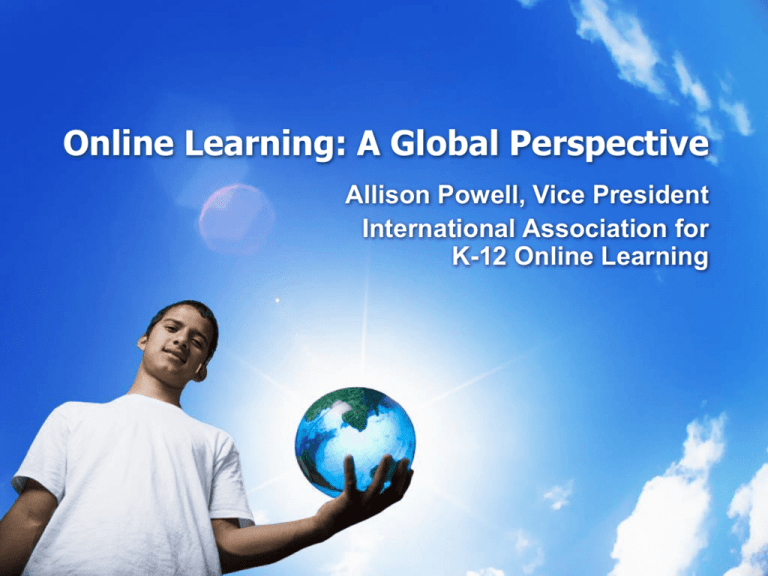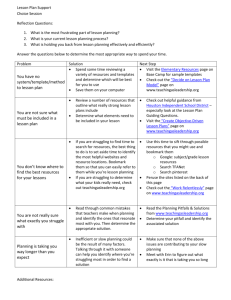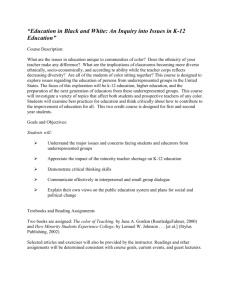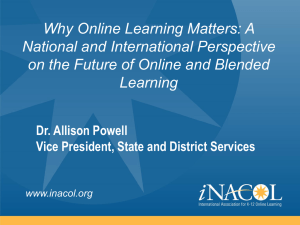Online Learning - EdTech Leaders Online
advertisement

Online Learning: A Global Perspective Allison Powell, Vice President International Association for K-12 Online Learning International Association for K-12 Online Learning (iNACOL) • iNACOL is the premier K-12 nonprofit in online learning • 2500+ members in K-12 virtual schools and online learning • Provides leadership, advocacy, research, training, and networking with experts in K-12 online learning. • “Ensure every student has access to the best education available regardless of geography, income or background.” • Conference – Virtual School Symposium (VSS): “Creating New Solutions Through Online Learning” in Austin, TX on November 15-17, 2009 iNACOL Policy Lens Every Student’s Right to Online Learning Opportunity Online learning is emerging as an essential part of the K-12 education landscape. To meet their educational goals and secure their future as active and productive citizens, K-12 students must have access to quality online learning opportunities in a variety of forms that meet their needs… iNACOL therefore will endeavor through its advocacy and policy activities to ensure that all students have the opportunity to choose an online learning course or program that meets their needs as part of their K-12 education. World Future Society The Futurist: Top 10 Breakthroughs Transforming Life over the next 20-30 years Best forecast data ever assembled 1. 2. 3. 4. 5. 6. 7. 8. 9. 10. Alternative energy Desalination of water Precision farming Biometrics Quantum computers Entertainment on demand Global access Virtual education or distance learning Nanotechnology Smart Robots Offering Academic Options Provides educational options to students unavailable at local school Provides equal access to educational opportunities regardless of location, socio-economic status, etc. Allows for scheduling flexibility (Students have access 24-7 from any Internet-connected computer.) Provides an NCLB highly qualified teacher in every classroom Meets the specialized needs of students (hospital/homebound, special education, student athletes, etc.) Personalizes education to address specific learning styles and student educational needs Multiple assessment types Content differentiation Do All Students Have Access to the Highest Quality Education? Virtual Schools offer: • Access to Courses Otherwise Unavailable (#1 USED study) • Online learning to Meet Individual Student Needs (#2) • “Advanced Diploma” Courses • Additional Course Offerings – Advanced Placement, IB or Dual Enrollment/Credit Courses – Math & Science Courses – Foreign Languages • • • • • Remedial courses and credit recovery Excellent teachers/Highly Qualified Teachers Multimedia/technology Tools to enhance instruction Customization and personalization; individualized pacing Tailored learning and access to more educational content and resources Providing Opportunities to All Students Traditional Public/Private Accelerated Students Credit Recovery Need to work and/or support family Medically Fragile Home Schoolers Special Education and ELL Aspiring athletes and performers National Perspective National Online Learning Facts • 34 states have state virtual schools (Keeping Pace 2008) • 44 states have significant state policies (KP 2007) • 21 states allow 200 full-time virtual charter schools with over 150,000 students (CER) • 30% of all employers use e-learning for training, in 5 years it will be 50% • 1 in 5 undergraduate and graduate student enrolls in an online course in higher education • More than 70% of school districts in the United States offer online courses to students (QED, America’s Digital Schools 2006) • More universities are offering K-12 courses online – MIT open courseware for K-12 students • K-12 Online Learning enrollments growing 30% annually nationwide with over 1,030,000 in 2007-2008 Michigan Online Learning HS Graduation Requirement • First state to require “online learning” in 2006 • In new requirements: “every student must have an online learning experience or course” before graduating from high school • Why? Need for online learning is greatest with students to access skills they will need to get ahead and compete in an increasingly technological workplace • The guidelines: – “Take an online course, or – Participate in an online experience (accumulation of 20 hours), or – Participate in online experiences incorporated in to each of the required credit courses of the Michigan Merit Curriculum State Snapshot: Florida • Growth and Sustainable Funding – 100,000 enrollments in Florida Virtual School (statewide supplemental online program) – 1/6 FTE; performance funding based on completion, not seat time – Set up as a separate LEA (school district) – No student may be denied access to online learning – 2007 Florida Tax Watch Report: • • • • Students academically performed better Served higher population of underserved students New standard of accountability Better use of tax payer dollars with results State Snapshot: Wisconsin • Lawsuit challenged full-time online schools over funding and role of teachers and parents • Online schools were threatened with closing and losing all funding • Legislature heard from students, parents, teachers, responded by updating law and changing the definitions in the education code to explicitly allow online schools State Trends: New Mexico • IDEAL-New Mexico (PK-20) – Statewide eLearning system that from its inception encompasses all aspects of learning from traditional public and higher education environments to teacher professional development, continuing education and workforce education. – Statewide eLearning delivery system for P-12, higher education, and state agencies. – Provide online courses that supplement the curricular offerings of New Mexico schools. – Creation of a statewide eLearning Service Center for P-12, higher education, and state agencies to support the use of the shared eLearning delivery system via the LMS. Alabama ACCESS • $30M over 3 years: upgrade network, 21st century classrooms, train teachers, invest in content • Goal: To deliver high quality courses to students statewide via online learning • Alabama Supercomputer Authority (ASA) is the networking technology partner for the ACCESS project • Funding 21st century classrooms using online learning • ACCESS students: Chinese, French, German and Latin; advanced placement (AP) calculus, AP English literature and composition, AP macroeconomics, and marine science are courses now available • "Using technology to provide those opportunities not only increases the rigor of instruction, but it also acclimates students to the use of technology and prepares them for a 21st century workforce.” -Governor Riley Distance Education at DegreeGranting Postsecondary Institutions: • 56% of all 2-year and 4-year institutions offer elearning courses • 127,000 online courses offered (2000-2001) • 90% use asynchronous Internet based courses • 51% use two-way interactive videoconferencing • In 2008, Sloan Consortium reports that there are approximately 4 million college students are currently enrolled in fully online courses. International Perspective International Trends in Online Learning • Results of the iNACOL International Survey – 2006, 15 countries responded – 2009, sent to over 100 countries International Trends • Turkey: 0-15 million students in K-12 taking online courses in 3 years • South Korea Virtual School • Hong Kong – Continuity in case of disasters • Mexico: – Digitized curriculum for all schools – K-12 academic content online – all teachers trained to use online content Canada • All thirteen provinces and territories have some level of K-12 distance education activity. • Two provinces make sole use of a single, province-wide K-12 distance education programme • four provinces rely primarily upon districtbased programmes • four provinces have a combination of a strong province-wide programme and several district-based programmes India • India: – Universal Access for K-12 Education in 10 years – Need 200,000 more schools – Shortage of good teachers – “Leverage teachers using technology to bring to scale” – Educomp Program digitizing learning resources (online content) in K-12 education • View as export opportunity China • China: 1.3 billion people • Digitized K-12 curriculum • Training Master Teachers to teach online • With online learning: increase educational opportunities to 100 million new students “Web opens world for young Chinese . . .” -Christian Science Monitor, May 14, 2007 Bejing -- “Excited and emboldened by the wealth of information they find on the Internet, Chinese teens are breaking centuries of tradition to challenge their teachers and express their opinions in class. . . .” “Students at Tianjin’s No. 1 Middle School are encouraged to challenge their history texts.” “The Internet has given Chinese children wings,” says Sun Yun Xiao, vice president of the China Youth and Children’s Research Center. 137 million online in China at the end of 2006 (in 1999 there were just 4 million connections in China) 87% of urban youth in China use the Internet How will they scale innovation with limited Internet access? • WiMax - everything is going to change. • WiMax has a 50Km/30 mile radius for highspeed, wireless broadband. • WiMax is going prime time in 2009 - 2010. • They will start putting towers up and expand broadband, mobile access, all over the country. EU • EU: – EU E-Learning Action Plan – IB Diploma Programme Online (125 countries) • UK: E-Learning Exports - 29 billion pounds annually; deal with China – Education as an export Singapore • Singapore: 100% of Secondary schools use online learning • All teachers trained to teach online • Blended Learning Environments • E-Learning Weeks Singapore’s Masterplans • • • Masterplan for ICT I (1997-2002) – Curriculum and Assessment. – Content and Learning Resources. – Physical and Technological Infrastructure. – Human Resources Development Masterplan for ICT II (2003-2008) – Students use ICT effectively for active learning. – Teachers use ICT effectively for professional and personal growth. – Connections between curriculum, instruction and assessment are enhanced using ICT. – Schools have the capacity and capability to use ICT for school improvement. – There is active research in ICT in education. – There is an infrastructure that supports widespread and effective use of ICT” (Koh and Lee, 2008, p.60-61). Masterplan for ICT III (2009-2014) – To strengthen integration of ICT into curriculum, pedagogy and assessment to enhance learning and develop competencies for the 21st century; – To provide differentiated professional development that is more practicebased and models how ICT can be effectively used to help students learn better; – To improve the sharing of best practices and successful innovations; and – To enhance ICT provisions in schools to support the implementation of mp3. Changing the Course of Education: the “Best of Both Worlds” • “Blended online learning should be approached as not only a temporal construct, but rather as a fundamental redesign of the instructional model with the following characteristics: • “A shift from lecture- to student-centered instruction where students become interactive learners (this shift should apply to entire course, including face-to-face sessions); • Increases in interaction between student-instructor, studentstudent, student-content, and student-outside resources; and • Integrated formative and summative assessment mechanisms for student and instructor.” - Educause, Blended Learning (2004) Blended/Hybrid Learning • “Combining face-to-face with fully online components optimizes both environments in ways impossible in other formats” Educause Research Bulletin, 2004 – Digital content, curriculum, LMS, online assessments, data system, AI, simulations – Shift in instructional model and training Struggling student, low-engagement, (More direct student support needed) Self-direction, high engagement, (Less direct student support needed) What Leaders Need to Know: Four Key Ideas • #1 Online Learning Expands Options • “The first impetus to the growth of K-12 distance education was an interest in expanding educational options and providing equal opportunities for all learners.” (p.7) • #2 Online Learning Is Rapidly Growing • “Recent Surveys show that K-12 online learning is a rapidly growing phenomenon.” (p.4) – – – – – Clark: 40,000-50,000 enrollments in 2000-2001 Eduventures: 300,000 K-12 enrollments online 2002-3 USED/NCES: 328,000 enrollments in distance ed 2002-3 Peak Group: 500,000 enrollments in 2005 Growing 30% annually Online Learning Works • #3 Is Effective: “Equal or Better” • “meta-analysis found that, on average, students in online learning conditions performed better than those receiving face-to-face instruction” (US DOE, 2009) • #4 Improves Teaching • Teachers who teach online reported positive improvements in face-to-face, too. • “Of those who reported teaching face-to-face while teaching online or subsequently, three in four reported a positive impact on their face-to-face teaching.” (p. 25) • “Using the Internet to deliver courses seems to contain great disruptive potential. It could allow a radical transformation to happen in an incremental, rational way.” -Clayton Christensen, Harvard Business School • Disrupting Class: How Disruptive Innovation Will Change the Way the World Learns predicts that the growth in computer-based delivery of education will accelerate swiftly until, by 2019, half of all high school classes will be taught over the Internet. • “Education over the Internet is going to be so big it is going to make e-mail look like a rounding error.” - John Chambers, Cisco CEO Thank you! Allison Powell apowell@inacol.org






